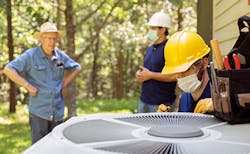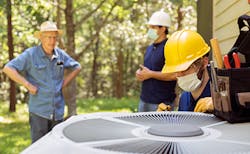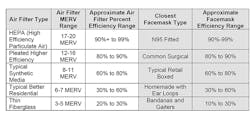In the HVAC industry, most of us understand air filtration principles. Like it or not, face filters or face masks are required by law when we're in public to protect against the spread of Covid-19. Let's look at what you already know about air filters that may help you and others improve the way you choose, wear, and use face filters to stay COVID-19-safe.
Choose the Right Face Filter
Besides the artwork you choose to display on your face, there are other criteria to consider when selecting the right mask for you. The three most important are fit, cleanliness, and efficiency. Since face mask efficiency depends on how well the mask fits your face and how clean it is, we'll save face mask and filter efficiency comparison for last.
Bypass Air
If a heating system has a 16 x 24 x 1-in. filter rack, its air filter's performance will be best if you choose one with the same dimensions.
Should you install a 12 x 24 x 1-in. filter, it will leave 25% of the filter rack area open. Since air (and any viruses in it) follow the path of least resistance, it will bypass the filter and move quickly through the system and back into the home.
The same principle applies to face masks. Oversized or undersized face masks contain gaps. This allows air (and any viruses in it) to bypass the face mask and move in and out of the person wearing the mask. This, of course, increases the chance of infection to them and anyone nearby.
Filter and Mask Cleanliness
This weekend I was in a store with a clerk who wore an oversized mask; there were significant gaps on both sides. The mask was old and stretched out of proportion. In my opinion, it was way past time for a face filter change. The mask kept slipping below his nose, and he kept touching the outside of his mask to scoot it up. I told him I didn't need a receipt or bag.
When wearing a face mask, you breathe in, and any viruses in the air are caught in the mask. This is why you wear a mask, mostly to protect you from those viruses, right? So, hopefully, any virus you want to keep out of your lungs gets caught on the outside of the mask.
Take a minute and think about that store clerk. Each time he touched his mask to cover his nose, he touched the dirtiest, nastiest, most infected surface in the store. After interacting with several hundred people, imagine the germs collected on the outside of that face mask.
Thinking about how I handle face masks and how often I clean and change them has been the most beneficial change I've made after comparing them to air filters.
Is the inside of your face mask pretty disgusting? Sure, but it's your "dirt." Whatever is inside your face filter is yours. So, the issue isn't quite as severe.
The store clerk's bad example helps us see how the outside of your mask is where it is most infected.
Now think about what you're exposed to when you take off your face filter, and all the nastiness caught on the outside of it. Do you pull it off the second you're outside the store, leave it flapping on your ear, shove it in your pocket or throw it between the seats in your truck? Then do you pull it back onto your face inside-out the next time you're required to wear it?
Thinking about how I handle face masks and how often I clean and change them has been the most beneficial change I've made after comparing them to air filters.
Filter and Facemask Efficiencies
After reading a half dozen highly technical papers about face masks, I concluded a simple study comparing air filter and face mask efficiencies doesn't exist.
So I created one. For the sake of simplicity, consider this unofficial table written -- in HVAC terms -- as a sort of efficiency comparison between air filters and face masks. It uses a typical air filter efficiency rating of MERV (Minimum Efficiency Reporting Values) to help us consider approximate efficiency comparisons between air filters and face masks.
Hopefully, this unofficial table will provide a general reference point for you to choose your face filters.
Remember, the face mask efficiency ranges are just approximations. They are not based on any studies or reports.
I laughed out loud at myself as I became aware and began to apply air filter lessons to how I wear and use face masks. Remember, face masks and filters hold particulates and viruses we all want to stay away from. Don't forget to choose and handle both filters accordingly.
Rob "Doc" Falke serves the industry as president of National Comfort Institute, Inc., an HVAC-based training company and membership organization. If you're an HVAC professional interested in a free procedure to measure air filter resistance to airflow, contact Doc at ncilink.com/ContactMe or call him at 800-633-7058. Go to NCI's website at nationalcomfortinstitute.com for free information, articles, downloads, and current training opportunities
About the Author
Rob 'Doc' Falke
President
Rob “Doc” Falke serves the industry as president of National Comfort Institute an HVAC-based training company and membership organization. If you're an HVAC contractor or technician interested in a building pressure measurement procedure, contact Doc at [email protected] or call him at 800-633-7058. Go to NCI’s website at NationalComfortInstitute.com for free information, articles and downloads.


